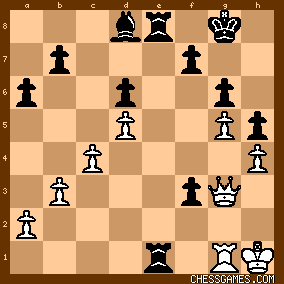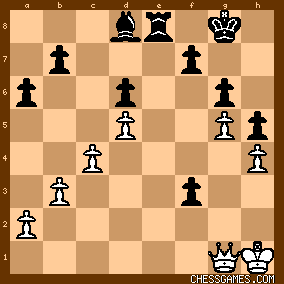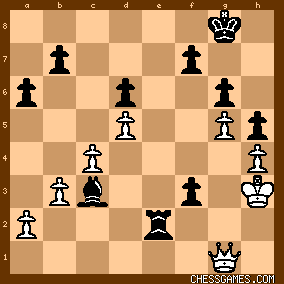|
< Earlier Kibitzing · PAGE 3 OF 3 ·
Later Kibitzing> |
Sep-09-12
 | | LoveThatJoker: <Guys> I don't have access to Stockfish at the moment, can someone be so kind to post engine analysis on the game continuation line, but with 35...f2 instead please? LTJ |
|
| Sep-09-12 | | sera: I came up with the solution to this
puzzle at a train station. |
|
Sep-09-12
 | | Jimfromprovidence: This is arguably the most difficult puzzle I have seen on this site. Take a look after 33 Qg3 (which <LTJ> also addresses).

click for larger viewWhite now double attacks the e1 rook. But if black plays 33…Rxg1+, then after 34 Qxg1 his attack fizzles, or does it? 
click for larger view
Then comes 34….Ba5!! (seeing 35…Re1). 35 Kh2 Re2+ 36 Kh3 Bc3!

click for larger view This beautiful move protects against 37 Qf1 because of 37…Be5, seeing 38…Rh2# White has no good moves left. If 37 Qh1, black can now win with 37…Rg2, seeing 38…Be5, 39… Rg3+. |
|
Sep-09-12
 | | chrisowen: I edict um bless queen under threat dutifuls in f2 or get queenin f5 ever the ogre at e8 could it swoop in e4 light up material i prefer re rob in e4 would satisfy it oh door cover beach in e4 diet he elephant omit pawnf2 and f5 lame so ping rook in e4 or donkey g1 down in a fashion g4queen in e1+ king stuffer h1 you see the point of holding off f3 rockg1 in only move then in pulp it rooke8 comes. |
|
Sep-09-12
 | | chrisowen: To the rescue, (h2 slide in ty) queeng3 or f2 emerge as the candidate am in too mind black hined quarter a lexicon elan in victory assured it bring back too f3 and waterboy b6 manage to bring home the point in volley it qf2 g3 in read it f1 surf in peel it rooke4 in parchment rook heads to g4 ie board bishop rote see tee f2 after h3 it kick off in bowing out plane to see massive edge for black hail a cabbie, re2 in ascents e1 i ment rookg4 eta g1 if taken h5 in whisk off e1 very it ascertain pieces for black plus the f3 provide compensation old one two sucker punch in strip effect it a nose in front support you gees left to his queens own devices bishop seal the wax in g4 then f2 in, |
|
| Sep-09-12 | | agb2002: Black has a bishop and a pawn for a knight.
White threatens 31.Rxg4.
The passed pawn suggests eliminating as many defenders as possible, starting with the knight 30... Rxe4 31.Rxg4 (31.Rxe4 Qxe4 - +) 31... Rxe1+ 32.Rg1 Rfe8 A) 33.Qxd6 f2 wins.
B) 33.Qf2 R1e2
B.1) 34.Qxf3 R8e3 35.Qf1 Bb6 threatening 36... Re4 looks good for Black. B.2) 34.Qf1 Bb6 is similar to B.1.
B.3) 34.Qg3 R8e4 followed by Rg4, Bb6, f2, Re1, etc.
C) 33.Qg3 R1e2 looks similar to previous lines. |
|
| Sep-09-12 | | Patriot: White threatens to snap off the queen.
30...Rxe4 31.Rxg4 Rxe1+ 32.Rg1 Rfe8
Now white cannot simply capture the rook without losing. 33.Qg3 Ba5 34.Qxf3
I'm not sure what I'm missing here. Oh well...I'll have to count this as a miss because this has already become too unrealistic and impractical. |
|
| Sep-09-12 | | Patriot: Ok, I didn't see the point behind 33.Qg3 Rxg1+ 34.Kxg1 Bb6+ which wins for black since 35.Kf1 f2, threatening 36...Re1+. I noticed 34.Qxg1 Ba5 threatening 35...Re1 with a pin but didn't see the win there either. 35.Qg3 Re1+ 36.Kh2 Re2+ 37.Kh3 f2 38.Qf3 Re3 39.Qxe3 f1=Q+ is one line Houdini says is accurate. |
|
| Sep-09-12 | | cyclon: Nice continuations many of you have here today. I looked once more into the position ( without the help of the silicon ). Move 33. c5 changes a little the character of the situation, but it isn't enough for White after 33. -R1e2, so it seems. But I returned into my previous 'instinctional' sub-note by move 33. Qxd6 mentioning that 33. -f2 wins outright. Still, this is a try to prolong the game just a little - for example 33. -f2 34.Rf1 Rxf1+ 35.Kg2 and Black seems to have to formulate a new plan in his winning efforts. If instead of 33. -f2, 33. -Ba5 ( 33. -Be7?? 34.Qg3 winning, even Rxe7 quarantees a draw ) 34. Qg3 (34. b4? [ 34. -f2 35.Rf1 ] 34. -R8e4 is bad new for White) and now if 34. -R8e4 then maybe 35. Kh2. I'm not claiming White holds, but can prolong a little. What do You say? |
|
| Sep-09-12 | | M.Hassan: "Insane"
Black to play 30...?
Black is a pawn up
30............Rxe4
31.Rxg4 Rxe1+
32.Rg1 Rfe8
33.Qg3 Rxg1+
34.Qxg1
So far, Black has taken two Rooks and a Knight and has given Queen and a Rook. The passed pawn on f3 is a source of great hope for Black. 34...........Ba5
35.Qg3
<if 35.Qf2 Re1+ 36.Kh2 Re2 and White Queen is lost> 35...........Re1+
36.Kh2 Re2+
37.Kh3 f2
38.Kg2 Bb6
39.Qd3 Re1
40.Qf1
There will be a severe struggle on the White's Kingside. I do not know how it will continue but looks like that White has to give his Queen for the pawn and the Rook to stop promotion of the f pawn.
Time to check |
|
| Sep-09-12 | | nummerzwei: It was kind of obvious that the solution had to start with 30...Rxe4. However, for some reason, I did not hit upon 33...R1e2.
Instead, I reasoned, 33...R1e3, intending to strengthen the position with Bb6-c5 first, should be sufficient. Fritz, at least, agrees. |
|
| Sep-09-12 | | rapidcitychess: I was staring at the puzzle intently... Trying to figure the depths of mystery that were legions beyond me, and any other ocean related metaphors I could think of. I quickly realized that I must have the thinking abilities of baby seals compared to the people who figured this out. I pondered over 30...f2, with my line being 31.Qxf2 Qh3+ 32.Qh2 Qf3+ 33.Rg2 with me winning the knight. But the wise among you quickly see the error of my way, being the fact that he can merely play 33.Qg2, and my best asset was sacrificed for naught. So then my wish was the hope that a Queen sac would lead to a good line.
So I attempte a hopeful sacrifice; 30...Qxe4: White will not stand for such nonsense, so he takes my foolish material sacrifice. 31.Rxe4 Rxe4 And now my main goal is to either promote or checkmate. All else are mere nugatory concerns. I want to play ...Bb6 and then quickly double my rooks, but how should I do this? His pieces are not well coordinated right now, but if he is given breath time, he might be able to form something. Now with the current position, if he relinquishes his grip upon the h4 pawn, I can take it and he is forced to give up his queen, and his position seems to crumble rather quickly. So it seems logical that he would both blockade the pawn and give his king some breath: 33.Rg1 Now it seems he cannot take the pawn because of threats upon the back rank. Now as in our original plan, I believe we should either move our bishop to an active position, or double our rooks. It seems the most likely idea would be to use our bishop to take away the breathing room he has, and threaten to advance my pawn farther, with my rooks attacking for support. Thus I would play 33...Bb6. Now he can't take the d6 pawn again, because that would force him to use his queen as a blocker. (Whether or not he could pull it off without my bishop is a rather unimportant concern, because it doesn't matter yet.) Perhaps he should alleviate the back rank threats with 34.Qg3. Now black will most likely have to press his pawn forward with 34...f7. I'm going for 35...Re1 next, or perhaps 35...Re8 with the same threats. I can't see any counterplay, but there probably is somewhere. That's my story, and I'm stickin' with it. Time to check. ...
I don't know about my line, I'm probably missing something really, really stupid about Qxe4. For the record, I saw it and figured it the same. |
|
| Sep-09-12 | | master of defence: What happens after 34.Qxf3 or 36.Qxf3? |
|
| Sep-09-12 | | rapidcitychess: <master of defense> Instead of answering your question, I'm going to ask you to read the previous posts. This question has already been answered. Thanks. c: |
|
| Sep-09-12 | | James D Flynn: Pieces are even, Black is an advanced P up and White’s K is somewhat exposed. The immediate problem he must face is Whites threat 31.RxQ . Candidates 30……Rxe4,f2,Qf4.
30…..Rxe4 31.Rxg4 Rxe1+(not Re2 32.Rxe2 fxe2 Rg1 33.Re8 Re1) 32.Rg8 Re8(threat Bb6) 33.Qf2(not Qxd6 f2) R1e2(not Bb6 34.Qxe1) 34 Qxf3 R8e3 and White must sacrifice his Q for a R to prevent Rh3#. 35.Qxe3 Rxe3 and
In case I don't get back after the U.s.open womens fianl, her are my thoughys so far.
Black is a piece up plus his R controls the only open file. The endgame will be easily won.
30……f2 31.Nxf2 Qf3+ 32.Qg2 Qxg2+ 33.Kxg2 f6 34.gxf6 Bxf6 35.Kg3 Bxh4+ 36.Kxh4 Rxe1 37.Rxe1 Rxf2 38.Re7 b5 with an interesting endgame where Whites Q-side and central pawns may give him better chances. |
|
| Sep-09-12 | | Tiggler: <sfm>: <Cutting to the bone, this one is genuine mutual zugzwang. White to move must accept a draw with e.g. QxR, but Black to move loses.> Mutual zugswang is a wonderful situation, if true, but cannot black move the e3 R anywhere on the file? Specifically, from your diagram, does not ... Re7 secure the draw for black? |
|
| Sep-09-12 | | Tiggler: <Eurotrash: I got the first move, so I take full credit.> Good for you, <Eurotrash>. Take it and run, I say. |
|
| Sep-09-12 | | Tiggler: <sfm> Only now I see your later correction. Great to be able to sprinkle traitor pawns into a position: I'll remember this move when next I need it. |
|
| Sep-09-12 | | JG27Pyth: Beautiful finish. I saw the sac idea and that it looked promising but finding moves like 35.R8e4! ... I can't pluck that move from the sea of possibilities at move 35 let alone calculate it from five moves out. |
|
| Sep-10-12 | | Abdel Irada: <A tale of two rooks>
Part 1 of 2
The key move and the immediate result (Black will have a rook, bishop and advanced passed pawn for his queen) required almost no thought; there is really no other productive way for Black to proceed. Therefore, <30. ...♖xe4!> may be regarded as a given, as may White's reply. <31. ♖xg4...>
Recapturing on e4 loses a piece and is tantamount to resignation. But here is where the road forks: Black may take either rook, and it's not immediately obvious which is the better choice. Competent others will doubtless have thoroughly explored the ramifications of the "correct" <31. ...♖xe1†>, which does appear to win for Black, although one has to look closely to find some of the continuations, as against 32. ♖g1, ♖fe8; 33. ♕f2, when Black wins with the surprising 33. ...♖1e2!, meeting 34. ♕xf3 with 34. ...♖8e3; 35. ♕f1, ♗b6 and White is in zugzwang. What interests me, therefore, is a look at the road less travelled: 31. ...♖xg4!?
Left alone, Black will follow with ...♗b6 and f2, when the pawn will become a thorn in White's side and a potential locus of a lethal chessic tetanus infection. Solid-looking defensive moves such as 32. ♕f2 aren't as safe as they appear: After 32. ...♖f4, White is faced with a quandary: He'd give a great deal to pick off the pawn on f3, but the only piece he can use to do this is his rook, and he can't play ♖e3 thanks to the pin ...♗b6, while encircling the pawn from any other square involves giving up control of the e-file, and if Black can get his other rook into play on that line, White is in deadly peril. This suggests more active play to keep the bishop off b6, but this also involves complex ramifications: 32. ♕xd6!?, ♖xh4†
33. ♔g1, ♗xg5
(See part 2 below) |
|
| Sep-10-12 | | Abdel Irada: <A tale of two rooks>
Part 2 of 2
What is White to do here? The alluring double attack 34. ♕g3? fails against the pin 34. ...♖g4, while thanks to the forking threat with that same move, ideas like 34. ♕e5?, ♖f4! lead to loss for White. This suggests removing the king to a less exposed square, but 34. ♔f1? is out thanks to 34. ...♖h1†; 35. ♔f2, ♗h4†, winning a rook. At first, I thought White could escape as follows: 34. ♔f2, ♖f4; 35. ♖e3? on the assumption that Black had to continue 35. ...♗h4†; 36. ♔f1, ♖f5, and after 37. ♕h2!, g5; 38. ♕h3, ♖f4; 39. ♖xf3!, g4; 40. ♕xh4, ♖xf3†; 41. ♔g2, ♖f5; 42. d6, f6; 43. ♕e1, ♖e5; 44. ♕b4, ♖d8; 45. c5 ∞, chances seem dynamically balanced. However, Black throws a wrench in the works with 35. ...♖f6!, winning the exchange and preserving the f-pawn. Another continuation for White also fails: 35. ♖e7?!, ♗h4†; 36. ♔f1, ♖d4!; 37. ♖e1, f2!; 38. ♖c1, ♖e8  . . I have no engine to check my analysis with, so it's very possible that White does have a resource I'm overlooking. I invite comment: *Is* there a refutation to the "wrong" recapture, 31. ...♖xg4!?, or does this alternative line also work? While this line isn't as "forcing" as the capture with check on e1 followed by doubling on the e-file, the move does have certain merits: It imprisons the king, so that any move of the White rook off the e-file (e.g, 32. ♖f1? invites ...♖e8 because taking the pawn allows mate. It also prepares to put the rook behind the passed pawn, where as any life master will tell you it belongs. :-) Therefore, please let me know your answer (and your engine's): <31. ...♖xg4: meritorious or meretricious?> |
|
| Oct-20-24 | | mel gibson: I saw the first ply straight away but not the whole sequence. Stockfish 17 says:
30. .. Rxe4
(30. .. Rxe4 (1. ... Rxe4 2.Rxg4 Rxe1+ 3.Rg1 Rfe8 4.Qf2 R1e2 5.Qxf3 R8e3 6.Qxe3 Rxe3 7.Kg2 Kf8 8.b4
Re4 9.Rc1 Rxh4 10.Rc3 Rd4 11.b5 axb5 12.cxb5 Rxd5 13.Rc8 Rxg5+ 14.Kh3 Ke7
) +7.77/49 642)
score for Black +7.77 depth 49. |
|
Oct-20-24
 | | An Englishman: Good Evening: Already knew this one, but nice to know me five remaining brain cells can still solve this 12 years later. Flubbed 3 this week. Oh, well--on to Monday! |
|
| Oct-20-24 | | vajeer: The key to this puzzle is to seet that the f3 pawn is immune. Then the puzzle becomes easy. I followed the sequence till move 34 where I selected 34...R8e4 which computer shows to be stronger than the text move

click for larger view |
|
Oct-20-24
 | | chrisowen: I'll jet it's hon my it's u z it's Rxe4 it's abled it's axled it's fa it's about lo it's at bob give go Rxe4 ea it's x |
|
 |
 |
|
< Earlier Kibitzing · PAGE 3 OF 3 ·
Later Kibitzing> |
|
|
|





